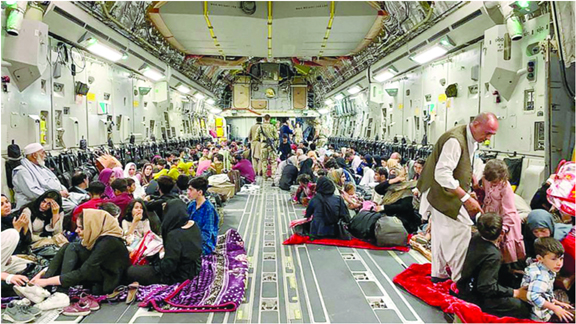
Afghanistan is in a state of disarray as the Taliban seized control of the country at a lightning speed following the pullout of troops by the United States and Nato. Within weeks, the Taliban swept from province to province until the group reached the presidential palace on Sunday, seizing power in the war-torn country.
The stunning military takeover has triggered a massive panic across the capital with thousands of Afghans swarming to the airport in a desperate attempt to flee the country, fearing a repeat of the Taliban’s brutal Islamist rule from 1996 to 2001.
On Monday, August 16, dramatic footage posted on social media showed hundreds of men running alongside a US air force plane as it rolled down the runway, with some clinging to the side of it. In other videos, civilians frantically clambered up an already overcrowded and buckling jetway.
President Ashraf Ghani fled as the Taliban reached Kabul on Sunday. Ghani left Afghanistan with the chief of staff, national security advisor and his family, as many on social media called him a coward and said they felt betrayed. However, Ghani said that he left to avoid further “bloodshed” in Afghanistan. As of now, it’s not clear where he went.
What next?
The US and international community are piling pressure on the Taliban to reach some kind of deal with the Afghan government. This will likely lead to Ghani stepping down from his post or he will be moved to a figurehead role.
The Taliban now control most of Afghanistan’s border crossings, which denies revenue for the government and enables the Taliban to tax trade to fund their fighting.
The Taliban might also permit groups like al Qaeda to train and operate from there, which is likely to make the country hotbed of terrorist activities.
Controlling the customs posts and border crossings (aside from Kabul airport) and with the Afghan military collapsing, the Taliban hold the cards. Russia and China will be comfortable engaging with the group’s leaders, according to experts.
An exodus of people from Afghanistan could include terrorists and Uyghur separatists, worrying the neighbouring countries including Tajikistan, Turkmenistan and Uzbekistan on the northern side.
Soviet invasion of Afghanistan
Soviet troops invaded Afghanistan in late December 1979. The Soviet Union intervened in support of the Afghan communist government in its conflict with anti-communist Muslim guerrillas during the Afghan War (1978–92) and remained in Afghanistan until mid-February 1989.
In April 1978 Afghanistan’s centrist government, headed by Pres. Mohammad Daud Khan, was overthrown by left-wing military officers led by Nur Mohammad Taraki. Power was thereafter shared by two Marxist-Leninist political groups, the People’s (Khalq) Party and the Banner (Parcham) Party—which had earlier emerged from a single organization, the People’s Democratic Party of Afghanistan—and had reunited in an uneasy coalition shortly before the coup. The new government, which had little popular support, forged close ties with the Soviet Union, launched ruthless purges of all domestic opposition, and began extensive land and social reforms that were bitterly resented by the devoutly Muslim and largely anti-communist population. Insurgencies arose against the government among both tribal and urban groups, and all of these—known collectively as the mujahideen (Arabic mujahidun, “those who engage in jihad”)—were Islamic in orientation.
These uprisings, along with internal fighting and coups within the government between the People’s and Banner factions, prompted the Soviets to invade the country on the night of December 24, 1979, sending in some 30,000 troops and toppling the short-lived presidency of People’s leader Hafizullah Amin. The aim of the Soviet operation was to prop up their new but faltering client state, now headed by Banner leader Babrak Karmal, but Karmal was unable to attain significant popular support. Backed by the United States, the mujahideen rebellion grew, spreading to all parts of the country. The Soviets initially left the suppression of the rebellion to the Afghan army, but the latter was beset by mass desertions and remained largely ineffective throughout the war.
The Afghan War quickly settled down into a stalemate, with more than 100,000 Soviet troops controlling the cities, larger towns, and major garrisons and the mujahideen moving with relative freedom throughout the countryside. Soviet troops tried to crush the insurgency by various tactics, but the guerrillas generally eluded their attacks. The Soviets then attempted to eliminate the mujahideen’s civilian support by bombing and depopulating the rural areas. These tactics sparked a massive flight from the countryside; by 1982 some 2.8 million Afghans had sought asylum in Pakistan, and another 1.5 million had fled to Iran. The mujahideen were eventually able to neutralize Soviet air power through the use of shoulder-fired antiaircraft missiles supplied by the Soviet Union’s Cold War adversary, the United States.
The mujahideen were fragmented politically into a handful of independent groups, and their military efforts remained uncoordinated throughout the war. The quality of their arms and combat organization gradually improved, however, owing to experience and to the large quantity of arms and other war matériel shipped to the rebels, via Pakistan, by the United States and other countries and by sympathetic Muslims from throughout the world. In addition, an indeterminate number of Muslim volunteers—popularly termed “Afghan-Arabs,” regardless of their ethnicity—traveled from all parts of the world to join the opposition.
The war in Afghanistan became a quagmire for what by the late 1980s was a disintegrating Soviet Union. (The Soviets suffered some 15,000 dead and many more injured.) Despite having failed to implement a sympathetic regime in Afghanistan, in 1988 the Soviet Union signed an accord with the United States, Pakistan, and Afghanistan and agreed to withdraw its troops. The Soviet withdrawal was completed on February 15, 1989, and Afghanistan returned to nonaligned status.
The rise of Taliban
The Taliban were removed from power in Afghanistan by US-led forces in 2001, but the group has seized control of the country once again following a rapid offensive.
The capital, Kabul, was the last major city to fall to the offensive that began months ago but accelerated as the hardline Islamists gained control of territories.
The group entered direct talks with the US back in 2018, and in February 2020 the two sides struck a peace deal that committed the US to withdrawal and the Taliban to preventing attacks on US forces. Other promises included not allowing al-Qaeda or other militants to operate in areas it controlled and proceeding with national peace talks.
But in the year that followed, the Taliban continued to target Afghan security forces and civilians, advancing rapidly across the country.
Rise to power
The Taliban, or “students” in the Pashto language, emerged in the early 1990s in northern Pakistan following the withdrawal of Soviet troops from Afghanistan. It is believed that the predominantly Pashtun movement first appeared in religious seminaries – mostly paid for by money from Saudi Arabia – which preached a hardline form of Sunni Islam.
The promise made by the Taliban – in Pashtun areas straddling Pakistan and Afghanistan – was to restore peace and security and enforce their own austere version of Sharia, or Islamic law, once in power.
From south-western Afghanistan, the Taliban quickly extended their influence. In September 1995 they captured the province of Herat, bordering Iran, and exactly one year later they captured the Afghan capital, Kabul, overthrowing the regime of President Burhanuddin Rabbani – one of the founding fathers of the Afghan mujahideen that resisted the Soviet occupation. By 1998, the Taliban were in control of almost 90% of Afghanistan.
Afghans, weary of the mujahideen’s excesses and infighting after the Soviets were driven out, generally welcomed the Taliban when they first appeared on the scene. Their early popularity was largely due to their success in stamping out corruption, curbing lawlessness and making the roads and the areas under their control safe for commerce to flourish.
But the Taliban also introduced or supported punishments in line with their strict interpretation of Sharia law – such as public executions of convicted murderers and adulterers, and amputations for those found guilty of theft. Men were required to grow beards and women had to wear the all-covering burka.
The Taliban also banned television, music and cinema, and disapproved of girls aged 10 and over going to school. They were accused of various human rights and cultural abuses. One notorious example was in 2001, when the Taliban went ahead with the destruction of the famous Bamiyan Buddha statues in central Afghanistan, despite international outrage.
Pakistan has repeatedly denied that it was the architect of the Taliban enterprise, but there is little doubt that many Afghans who initially joined the movement were educated in madrassas (religious schools) in Pakistan.
Pakistan was also one of only three countries, along with Saudi Arabia and the United Arab Emirates (UAE), which recognised the Taliban when they were in power in Afghanistan. It was also the last country to break diplomatic ties with the group.
At one point, the Taliban threatened to destabilise Pakistan from areas they controlled in the north-west. One of the most high-profile and internationally condemned of all Pakistani Taliban attacks took place in October 2012, when schoolgirl Malala Yousafzai was shot on her way home in the town of Mingora.
A major military offensive two years later following the Peshawar school massacre greatly reduced the group’s influence in Pakistan though. At least three key figures of the Pakistani Taliban had been killed in US drone strikes in 2013, including the group’s leader, Hakimullah Mehsud.
Al-Qaeda ‘sanctuary’
The attention of the world was drawn to the Taliban in Afghanistan in the wake of the 11 September 2001 World Trade Center attacks in New York. The Taliban were accused of providing a sanctuary for the prime suspects – Osama Bin Laden and his al-Qaeda movement.
On October 7, 2001, a US-led military coalition launched attacks in Afghanistan, and by the first week of December the Taliban regime had collapsed. The group’s then-leader, Mullah Mohammad Omar, and other senior figures, including Bin Laden, evaded capture despite one of the largest manhunts in the world.
Many senior Taliban leaders reportedly took refuge in the Pakistani city of Quetta, from where they guided the Taliban. But the existence of what was dubbed the “Quetta Shura” was denied by Islamabad.
Despite ever higher numbers of foreign troops, the Taliban gradually regained and then extended their influence in Afghanistan, rendering vast tracts of the country insecure, and violence in the country returned to levels not seen since 2001.
There were numerous Taliban attacks on Kabul and, in September 2012, the group carried out a high-profile raid on Nato’s Camp Bastion base.
Hopes of a negotiated peace were raised in 2013, when the Taliban announced plans to open an office in Qatar. But mistrust on all sides remained high and the violence went on.
In August 2015, the Taliban admitted they had covered up Mullah Omar’s death – reportedly of health problems at a hospital in Pakistan – for more than two years. The following month, the group said it had put aside weeks of infighting and rallied around a new leader in the form of Mullah Mansour, who had been the deputy of Mullah Omar. At around the same time, the Taliban seized control of a provincial capital for the first time since their defeat in 2001, taking control of the strategically important city of Kunduz.
Mullah Mansour was killed in a US drone strike in May 2016 and replaced by his deputy Mawlawi Hibatullah Akhundzada, who remains in control of the group.
Seizing power
In the year following the US-Taliban peace deal of February 2020 – which was the culmination of a long spell of direct talks – the Taliban appeared to shift their tactics from complex attacks in cities and on military outposts to a wave of targeted assassinations that terrorised Afghan civilians.
The targets – journalists, judges, peace activists, women in positions of power – suggested that the Taliban had not changed their extremist ideology, only their strategy.
Despite grave concerns from Afghan officials over the government’s vulnerability to the Taliban without international support, the new US president, Joe Biden, announced in April 2021 that all American forces would leave the country by 11 September – two decades to the day since the felling of the World Trade Center.
Having outlasted a superpower through two decades of war, the Taliban began seizing vast swathes of territory, before once again toppling a government in Kabul in the wake of a foreign power withdrawing.
They swept across Afghanistan in just 10 days, taking their first provincial capital on 6 August . By 15 August, they were at the gates of Kabul.
Their lightning advance prompted tens of thousands of people to flee their homes, many arriving in the Afghan capital, others heading for neighbouring countries.
The Taliban’s return to rule brings an end to almost 20 years of a US-led coalition’s presence in the country.
American presence in Afghanistan
Following the Taliban’s capture of Kabul on Aug. 15, the two-decade American era in Afghanistan appears to be finally over, and it is worth reflecting on what led up to this point. Here is an overview of some of key periods in the conflict.
The George W. Bush administration
The US entered Afghanistan as part of its War on Terror following 9/11, with a goal of defeating Al-Qaeda and the Taliban. But what was intended to be a quick and decisive show of force turned into a long and deadly war.
2001: The Sept.11 attacks on the World Trade Center and the Pentagon marked the beginning of the War on Terror. The US invaded Afghanistan.
2003: In May, US defense secretary Donald Rumsfeld announced that “major combat” operations had ended in the country, and that efforts would be shifted to reconstruction.
2004-2006: Several years of fighting ensued between a US-led military coalition and the Taliban. In this time, the Afghanistan government (with US support) established a new constitution, and elected Hamid Karzai as president. By mid-2006, Taliban forces were resurgent.
The Obama administration
The early Barack Obama years were marked by an increased US presence in Afghanistan. After overseeing the killing of Osama bin Laden, Obama set out a plan to leave Afghanistan in his second term.
2009-2010: Obama made a renewed commitment to Afghanistan. This included sending a surge of 17,000 troops to the country in Feb. 2009, and shifting strategy to focus on fighting Taliban and Al-Qaeda militants in Pakistan as well.
2011: US Navy SEALS carried out a successful mission to kill Osama bin Laden.
2013: NATO forces (led by the US) officially handed over security responsibility to Afghan military forces. The US military stayed on mostly in a training capacity and for specific counterterrorism efforts.
2014: President Obama announced a timeline for the withdrawal of US troops, but the Taliban were once again active in various parts of the country, and the Americans stayed longer.
In a reversal of policy, Trump initially escalated engagement and promised to “fight to win.” Trump did eventually withdraw some forces, but Taliban power continued to grow. There were unsuccessful peace talks between the US, Taliban, and Afghan governments.
2017: In August, president Trump introduced a new policy towards Afghanistan, ramping up the US presence on the ground for as long as it took to win instead of focusing on timetables for withdrawal.
2019: The Taliban and US government entered a round of peace talks that one US special envoy described as “more productive than they have been in the past.” The two sides reached a tentative peace agreement that involves US withdrawal of troops and a commitment that the Taliban will not harbor other jihadist groups. By September, Trump had canceled the deal.
2020: In February, US and Taliban leaders signed a peace deal, but it didn’t hold; conflict quickly resumed. In November, the Pentagon announced plans to withdraw troops as Trump’s presidency ended.
The Biden administration
Biden came into office with a commitment to ending the US’ war in Afghanistan. This approach has garnered criticism for the humanitarian and national security crises that could arise from the absence of US forces in the region.
2021: As president-elect, Joe Biden promised to withdraw all US troops from Afghanistan. By April, he said that this process would be complete by September, on the 20th anniversary of the 9/11 attacks. As the Taliban closed in on Kabul in August, Biden temporarily deployed a total of 5,000 troops to evacuate US embassy personnel.





Be the first to comment